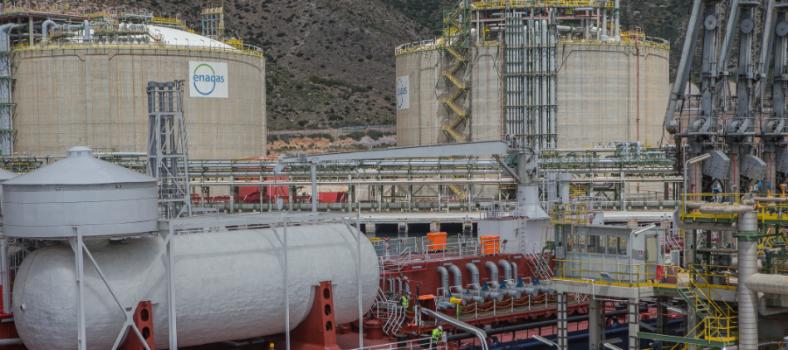This pioneering operation for Europe took place within the framework of the CORE LNGas hive project, co-funded by the European Commission, to promote LNG in transport, particularly maritime transport.
Repsol and Enagás have for the first time in Europe supplied a ship with liquefied natural gas (LNG) fuel directly from a regasification plant. Coordination between Repsol and Enagás allowed the successful completion of the operation, which lasted five hours. Repsol, as bunker supplier, and Enagás, as infrastructure manager, provided the technical and human resources required to perform the operation at the Enagás regasification plant in Cartagena.
This type of supply, pioneering in Europe, is known as pipe-to-ship bunkering, and was carried out using flexible cryogenic transfer hoses connecting the ship directly to the terminal. The ship, the Damia Desgagnés, received 370 m3 of LNG. This amount means that the bunkering operation was the largest to have been performed to date in Spain and by Repsol, given that amounts up to 320 m3 had been supplied in previous operations using tanker trucks.
The Damia Desgagnés, which flies the Canadian flag, was built in Turkey with a length of 135 metres, a breadth of 35 metres and a double hull. Its most notable characteristic is that it can be propelled using the three possible fuels: heavy fuel oil, marine diesel oil and LNG. It is also the first LNG-propelled asphalt tanker.
The use of LNG as a fuel contributes to improving air quality. LNG is an eco-friendly fuel because it does not produce emissions of sulphur oxide (SOx) or particulate matter (PM), and substantially reduces emissions of CO2 and nitrogen oxides (NOx), which allows increasingly stringent environmental regulations and emission reduction targets to be met.
This type of supply was made possible as a result of the adaptations made to the Enagás plant jetty in the Port of Cartagena, in accordance with industry standards. It also highlights the commitment to innovation in the provision of new services by regasification plants.
This operation was fruit of the collaboration between Repsol, Enagás and the Port of Cartagena Authority, and took place within the CORE LNGas hive project, co-funded by the European Commission, which is coordinated by Enagás and spearheaded by the Spanish Ports Authority. This initiative is turning Spain into the leader in this field in Europe, which is also aided by its privileged geographical placement as the gateway to the Mediterranean and the Atlantic.
The aim of the project, in which a total of 42 partner entities participate, is to develop a safe and efficient, integrated logistics and supply chain to supply LNG fuel to the transport industry, particularly the marine transport of the Iberian Peninsula.
More specifically, in addition to necessary port works, the aim of the project for the Port of Cartagena is the adaptation of one of the Enagás regasification plant jetties to enable it to offer new small-scale and bunkering services. This initiative has an estimated cost of 2.73 million and is being coordinated and executed in conjunction with the Port of Cartagena Authority. It is expected to be completed by the end of the year.
Source and more information: Enagas



